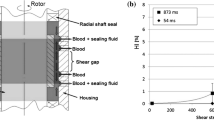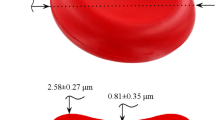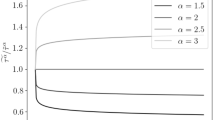Abstract
Hemolysis is a major concern in blood-circulating devices, which arises due to hydrodynamic loading on red blood cells from ambient flow environment. Hemolysis estimation models have often been used to aid hemocompatibility design. The preponderance of hemolysis models was formulated on the basis of laminar flows. However, flows in blood-circulating devices are rather complex and can be laminar, transitional or turbulent. It is an extrapolation to apply these models to turbulent flows. For the commonly used power-law models, effective stress has often been represented using Reynolds stresses for estimating hemolysis in turbulent flows. This practice tends to overpredict hemolysis. This study focused on the representation of effective stress in power-law models. Through arithmetic manipulations from Navier–Stokes equation, we showed that effective stress can be represented in terms of energy dissipation, which can be readily obtained from CFD simulations. Three cases were tested, including a capillary tube, the FDA benchmark cases of nozzle model and blood pump. The results showed that the representation of effective stress in terms of energy dissipation greatly improved the prediction of hemolysis for a wide range of flow conditions. The improvement increases as Reynolds number increases; the overprediction of hemolysis was reduced by up to two orders of magnitude.













Similar content being viewed by others
References
Arvand A, Hormes M, Reul H (2005) A validated computational fluid dynamics model to estimate hemolysis in a rotary blood pump. Artif Organs 29:531–540
Bhushan S, Walters DK, Burgreen GW (2013) Laminar, turbulent, and transitional simulations in benchmark cases with cardiovascular device features. Cardiovasc Eng Technol 4:408–426
Bluestein M, Mockros LF (1969) Hemolytic effects of energy dissipation in flowing blood. Med Biol Eng 7:1–16
Cao SJ, Meyers J (2012) On the construction and use of linear low-dimensional ventilation models. Indoor Air 22:427–441
Cao SJ, Meyers J (2013) Influence of turbulent boundary conditions on RANS simulations of pollutant dispersion in mechanically ventilated enclosures with transitional slot Reynolds number. Build Environ 59:397–407
Cao SJ, Cen D, Zhang W, Feng Z (2017) Study on the impacts of human walking on indoor particles dispersion using momentum theory method. Build Environ 126:195–206
Chen Y, Sharp MK (2011) A strain-based flow-induced hemolysis prediction model calibrated by in vitro erythrocyte deformation measurements. Artif Organs 35:145–156
Deng HY, Feng Z, Cao SJ (2018) Influence of air change rates on indoor CO2 stratification in terms of Richardson number and vorticity. Build Environ 129C:74–84
Ding J, Niu S, Chen Z, Zhang T, Griffith BP, Wu ZJ (2015) Shear-induced hemolysis: species differences. Artif Organs 39:795–802
Ezzeldin HM, de Tullio MD, Vanella M, Solares SD, Balaras E (2015) A strain-based model for mechanical hemolysis based on a coarse-grained red blood cell model. Ann Biomed Eng 43:1398–1409
Faghih MM, Sharp MK (2018) Characterization of erythrocyte membrane tension for hemolysis prediction in complex flows. Biomech Model Mechanobiol 17:827–842
Fraser KH, Taskin ME, Griffith BP (2011) The use of computational fluid dynamics in the development of ventricular assist devices. Med Eng Phys 33:263–280
Garon A, Farinas M (2004) Fast Three-dimensional numerical hemolysis approximation. Artif Organs 28:1016–1025
Ge L, Dasi L, Sotiropoulos F, Yoganathan AJ (2008) Characterization of hemodynamic forces induced by mechanical heart valves: Reynolds vs. viscous stresses. Ann Biomed Eng 36:276–297
Giersiepen M, Wurzinger LJ, Opitz R, Reul H (1990) Estimation of shear stress-related blood damage in heart valve prostheses-in vitro comparison of 25 aortic valves. Int J Artif Organs 13:300–306
Grigioni M, Caprari P, Tarzia A, D’Avenio G (2005) Prosthetic heart valves’ mechanical loading of red blood cells in patients with hereditary membrane defects. J Biomech 38:1557–1565
Hariharan P, Giarra M, Reddy V, Day SW, Manning KB, Deutsch S, Stewart SF, Myers MR, Berman MR, Burgreen GW, Paterson EG (2011) Multilaboratory particle image velocimetry analysis of the FDA benchmark nozzle model to support validation of computational fluid dynamics simulations. J Biomech Eng 133:041002
Herbertson LH, Olia SE, Daly A, Noatch CP (2015) Multilaboratory study of flow-Induced nozzle model. Artif Organs 39:237–259
Heuser G, Opitz RA (1980) Couette viscometer for short-time shearing of blood. Biorheology 17:17–24
Hund SJ, Antaki JF, Massoudi M (2010) On the representation of turbulent stresses for computing blood damage. Int J Eng Sci 48:1325
Jones SA (1995) A relationship between Reynolds stresses and viscous dissipation: implications to red cell damage. Ann Biomed Eng 23:21–28
Kameneva MV, Burgreen GW, Kono K, Repko B, Antaki JF, Umezu M (2004) Effects of turbulent stresses upon mechanical hemolysis: experimental and computational analysis. ASAIO J 50:418–423
Li MX, Yan YH, Zhao Bin TuJY, Liu JJ, Li Fei, Wang CC (2018) Assessment of turbulence models and air supply opening models for CFD modelling of airflow and gaseous contaminant distributions in aircraft cabins. Indoor Built Environ 27:606–621
Malinauskas RA, Hariharan P, Day SW, Herbertson LH, Buesen M, Steinseifer U, Aycock KI, Good BC, Deutsch S, Manning KB, Craven BA (2017) FDA benchmark medical device flow models for CFD validation. ASAIO J 63:150–160
Morshed KN, Bark D Jr, Forleo M, Dasi LP (2014) Theory to predict shear stress on cells in turbulent blood flow. PLoS ONE 9:e105357
Park SJ, Tector A, Piccioni W, Raines E, Gelijns A, Moskowitz A, Rose E, Holman W, Furukawa S, Frazier OH, Dembitsky W (2005) Left ventricular assist devices as destination therapy: a new look at survival. J Thorac Cardiovasc Surg 129:9–17
Pope SB (2000) Turbulent flows. Cambridge University Press, Cambridge
Quinlan NJ (2014) Mechanical loading of blood cells in turbulent flow. In: Doyle B, Miller K, Wittek A, Nielsen MFP (eds) Computational biomechanics for medicine: fundamental science and patient-specific applications. Springer, NewYork, pp 1–13
Quinlan NJ, Dooley P (2007) Models of flow-induced loading on blood cells in laminar and turbulent flow, with application to cardiovascular device flow. Ann Biomed Eng 35:1347–1356
Rose EA, Gelijns AC, Moskowitz A, Heitjan DF, Stevenson LW (2001) Long-term use of a left ventricular assist device for end-stage heart failure. N Engl J Med 345:1435–1443
Segalova PA, Rao KTV, Zarins CK, Taylor CA (2012) Computational modeling of shear-based hemolysis caused by renal obstruction. J Biomech Eng 134:021003
Sohrabi S, Liu Y (2017) A cellular model of shear-induced hemolysis. Artif Organs 35:1180–1186
Song X, Throckmorton AL, Wood HG, Antaki JF, Olsen DB (2003) Computational fluid dynamics prediction of blood damage in a centrifugal pump. Artif Organs 27:938–941
Vitale F, Nam J, Turchetti L, Behr M, Raphael R, Annesini MC, Pasquali M (2014) A multiscale, biophysical model of flow-induced red blood cell damage. AIChE J 60:1509–1516
Wu P, Meyers J (2011) Globally conservative high-order filters for large-eddy simulation and computational aero-acoustics. Comput Fluids 48:150–162
Wu P, Meyers J (2013) A constraint for the subgrid-scale stresses in the logarithmic region of high Reynolds number turbulent boundary layers: a solution to the log-layer mismatch problem. Phys Fluids 25:349–374
Wu J, Paden BE, Borovetz HS, Antaki JF (2009) Computational fluid dynamics analysis of blade tip clearances on hemodynamic performance and blood damage in a centrifugal ventricular assist device. Artif Organs 34:402–411
Wu P, Gross-Hardt S, Boehning F, Hsu PL (2018a) On the accuracy of hemolysis models in Couette-type blood shearing devices. Artif Organs 42(10):E290–E303
Wu P, Feng Z, Cao SJ (2018b) Fast and accurate prediction of airflow and drag force for duct ventilation using wall-modeled Large-eddy simulation. Build Environ 141:226–235
Zhang T, Taskin ME, Fang HB, Pampori A, Jarvik R, Griffith BP, Wu ZJ (2011) Study of flow-induced hemolysis using novel Couette-type blood shearing devices. Artif Organs 35:1180–1186
Zhou Y, Deng YL, Wu P, Cao SJ (2017) The effects of ventilation and floor heating systems on the dispersion and deposition of fine particles in an enclosed environment. Build Environ 125:192–205
Zhou Q, Qian H, Liu L (2018) Numerical investigation of airborne infection in naturally ventilated hospital wards with central-corridor type. Indoor Built Environ 27:59–69
Acknowledegements
The authors also would like to acknowledge the coordinated support from Natural Science Foundation of China (Grant No. 51406127); Natural Science Foundation of Jiangsu Province (Grant No. BK20140344). Insightful comments by the reviewers are also acknowledged.
Author information
Authors and Affiliations
Corresponding author
Ethics declarations
Conflict of interest
The authors declare that they have no conflicts of interest.
Additional information
Publisher's Note
Springer Nature remains neutral with regard to jurisdictional claims in published maps and institutional affiliations.
Rights and permissions
About this article
Cite this article
Wu, P., Gao, Q. & Hsu, PL. On the representation of effective stress for computing hemolysis. Biomech Model Mechanobiol 18, 665–679 (2019). https://doi.org/10.1007/s10237-018-01108-y
Received:
Accepted:
Published:
Issue Date:
DOI: https://doi.org/10.1007/s10237-018-01108-y




